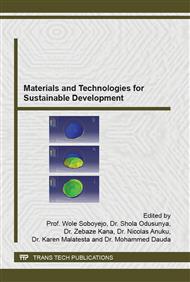[1]
E.O. Obanijesu, V. Pareek, R. Gubner, and M.O. Tade, Corrosion education as a tool for the survival of natural gas industry.
Google Scholar
[2]
Dr, V.R. Krishnan, Corrosion Issues in Pipelines.
Google Scholar
[3]
Andrew, Cosham, The assessment of corrosion in pipelines.
Google Scholar
[4]
Farshana Pervin, Yuanari Zhou, Mohammada, Biswas, Vijaya K. Rangari, Shaik Jeelani Tuskegee University's Center for Advanced Materials (T-CAM), Tuskegee, Al 36088, US11. ).
Google Scholar
[5]
Kshrisager, R, A. Lopez-Anido and R. K, Gupta, 200. Environmental aging of fiber-reinforced polymer-wrapped concrete cylinders. ACI Mater. J, 97: 703-712.
DOI: 10.14359/9985
Google Scholar
[6]
D. Melot, G. Paugam, and M. Roche, Total SA, France.
Google Scholar
[7]
N. Abacha*, M. Kubouchi, K. Tsuda, T. Sakai, Performance of epoxy-nanocomposite under corrosive environment.
DOI: 10.4028/www.scientific.net/kem.353-358.2167
Google Scholar
[8]
S. MARTINEZ 1, V. GROZDANIĆ 2, Scientific paper A. IVANKOVIĆ 1 UDC: 620. 193. 1. 4: 622. 648. 2/. 3 SEM/EDS analysis of corrosion products from the interior of a crude oil pipeline.
Google Scholar
[9]
Smart, J., Pickthall, T. and Carlile, A., Using OnLine Monitoring To Solv] A. S. Gajić, M. V. Tomić, Lj. J. Pavlović,M. G. Pavlović: Kvalitet vode kao jedan od mogućih uzročnika korozije u termoenergetskim postrojenjima, Zastita materijala, 51, 2010, 1, pp.29-35.
Google Scholar
[10]
( http: /corrosion-doctors. org/Pipeline/Internal-corrosion. htm).
Google Scholar
[11]
Mythili Koteeswaran, CO2 and H2S Corrosion in Oil Pipelines, Master Thesis.
Google Scholar
[12]
Groysman, A. and Erdman, N., 2000, A Study of Corrosion of Mild Steel in Mixtures of Petroleum Distillates and Electrolytes, Corrosion, 56, 1266-1271.
DOI: 10.5006/1.3280515
Google Scholar
[13]
decks' Kuruvila Varughese, Product Manager , herberts-O, brien Inc, 9800 Genard Rd, Housten Tx. 77040, Role of adhesion and wetting of fussion bonded epoxy coatings in corrosion control of Rebar used in bridge.
Google Scholar
[14]
[http: /www. epotek. com/ ].
Google Scholar
[15]
Pierre R. Roberge, Ph.D., P. Eng, Corrosion Engineering Principles and Practice New York Chicago San Francisco Lisbon London Madrid Mexico City Milan New Delhi San Juan Seoul Singapore.
Google Scholar
[16]
A.F. Abdelkader and J.R. White, J. Applied Polymer Science, 98 (2005) 2544-2549.
Google Scholar
[17]
D.W. Van Krevelen and P.J. Hoftyzer, Properties of Polymers - Their Estimation and Correlation with Chemical Structure, second edition, Elsevier Scientific Publishing Company, (1976).
Google Scholar
[18]
SANDIA REPORT SAND2009-4405 Unlimited Release Printed July 2009, Interaction of Water with Epoxy Dana A. Powers.
Google Scholar
[19]
Jang-KyKim, Chugang Hu, Ricky S. C, WOO. Ivan, Man-lung Sham, (Pre Puplished Version) a Moiture Barrier Characteristics of organoclay-epoxy Nanocomposites. Department of Mechanical Engineering, HongKong University of Science and Technology clear water Bay Hongkong.
Google Scholar
[20]
William. D. Callister, Jr., (2007); Material Science and Engineering, Seventh Edition, John Wiley & Sons, Inc.,. ISBN-13: 978-0-471-73696-7. 621-6647. Metal hank book. 190].
Google Scholar
[21]
M. S. Bhatnaga , The Polymeric Materials Encyclopedia © 1996 CRC Press, Inc.
Google Scholar
[22]
CHRISTOPHER L. SOLES, * ALBERT F. YEE, Received 24 February 1999; revised 13 September 1999; accepted 13 December 1999, A Discussion of the Molecular Mechanisms of Moisture Transport in Epoxy Resins Department of Materials Science & Engineering, University of Michigan, Ann Arbor, Michigan 48109-2136.
DOI: 10.29026/oes.2022.210012
Google Scholar
[23]
Shirangi M. H12 , FanX. J3, and Michel, Mechanism of moisture diffusion, hygroscopic swelling and adhesion degradation in epoxy molding compounds, B1. Micromaterials center, Fraunhofer institute for reliability and microintergration IZM, Berlin, Germany, 2Robert Bosch GMHBH, Automotive Electronics, IC Packaging department, Reutigen, PO Box 28, Beaumont Texas 77710, USA.
DOI: 10.1007/978-1-4419-5719-1_2
Google Scholar
[24]
Shirangi M. H, Auersperg J., Kooyuncy M., Walter H., Muller W.H., and Michel B. characterization of dual stage moisture absorption, residual moisture content and hygroscopic swelling of epoxy molding compounds proc, 9th Eurosime2008, Freiburg Germany pp.455-462.
DOI: 10.1109/esime.2008.4525009
Google Scholar
[25]
Weitsman, Y.J., Anomalous fluid sorption in polymeric composites and its relation to fluid induced damage, Part A 37(2006) pp.617-623.
DOI: 10.1016/j.compositesa.2005.05.022
Google Scholar


